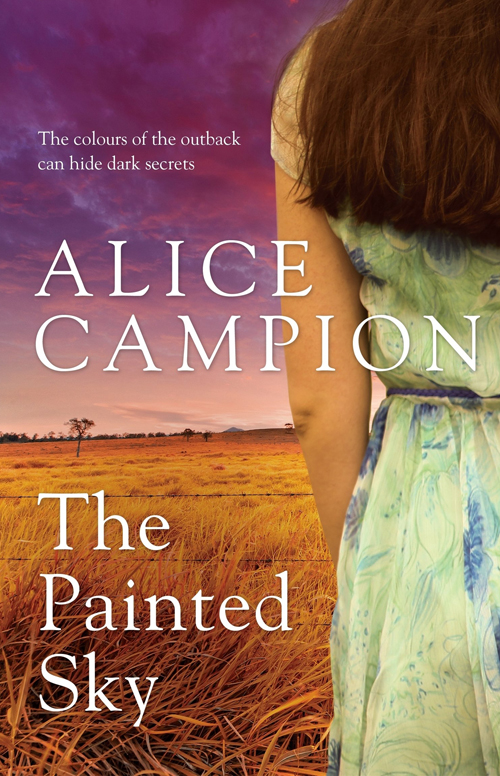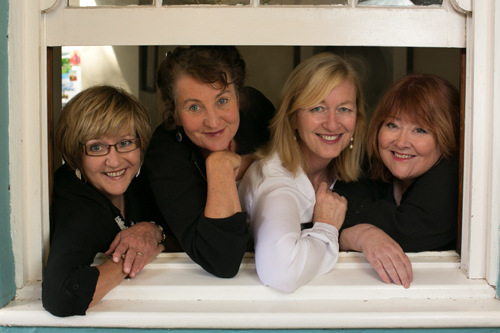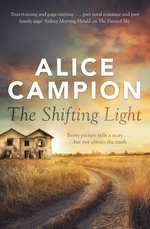 As many of you know, I recently co-wrote a book with nine(!) authors (“Into Tordon” by Z.F. Kingbolt), so am particularly fascinated by collaborative writing at the moment. ‘Alice Campion’ is the pseudonym of several authors writing as one: Jane Richards, Jenny Crocker, Jane St Vincent Welch and Denise Tart. Their second book, “The Shifting Light”, is due to be released by Penguin Random House early in 2017. Their first novel “The Painted Sky” was also written with Madeline Oliver.
As many of you know, I recently co-wrote a book with nine(!) authors (“Into Tordon” by Z.F. Kingbolt), so am particularly fascinated by collaborative writing at the moment. ‘Alice Campion’ is the pseudonym of several authors writing as one: Jane Richards, Jenny Crocker, Jane St Vincent Welch and Denise Tart. Their second book, “The Shifting Light”, is due to be released by Penguin Random House early in 2017. Their first novel “The Painted Sky” was also written with Madeline Oliver.
Jenny Crocker is a communications manager who uses her work to create positive change in the world. She has been a journalist and non-fiction author and likes to escape to her small hazelnut farm in northern NSW.
Jane Richards is a senior editor and journalist at Fairfax Media. She loves mysteries and secrets.
Jane St Vincent Welch spent her childhood on a property in the New England region of NSW. She works in Sydney as a documentary editor.
Denise Tart is a marriage celebrant with a background in performance and event management. She has written for the theatre and business, but now mainly pens meaningful and romantic ceremonies. Denise loves a good yarn.
So how did so many authors go about collaborating over the writing of their awesome books? To find out, I asked Jane Richards…
When you write collaboratively, how do you make the decisions? Do you all have an equal say? What happens when there’s a stalemate?
We generally plot the ‘scenes’ together first and basically outline what is to happen – whose point of view the scene is to be written in and what emotions/reactions we want our characters to feel and express. We also outline how each character should ‘progress’ by the end of the scene – so when we present our writing there are no major surprises. But of course, one of us may be struck by an idea to make the scene work better or discover a discrepancy when they are writing that we haven’t thought of. If so, they will flag this to the group before the writing is presented. So basically we have quite a detailed outline of what we want and are expecting but we also are very willing to let the writer of that particular scene have the freedom to suggest additions. There have generally been few stalemates – and if we have one we put it to the vote. We all have an equal say, though we do take each other’s various expertise in certain things into account. Funnily enough the most disagreements we’ve had were way back when we were writing The Painted Sky and tackled our first sex scenes. These were quite robust and funny! Discussions about what sort of language was too anatomical or sexy/unsexy, etc. Hilarious now when we think of it!

‘Alice Campion’: Denise Tart, Jane St Vincent Welch, Jane Richards & Jenny Crocker.
Did you agree that was how things were going be before you started writing, or did your working relationship evolve into that system, and were there any hurdles with that?
Our system evolved over time when we were writing the first book, but by the second book we had that system firmly in place and it was never questioned – mainly because it worked so well for us. None of us are shrinking violets and occasionally we’d have robust discussions but were also respectful of each other and are great friends so this helped. We had a couple of rules that we followed: namely we were honest with criticism but we also had to be specific, solutions focused and sensitive. For example it was never enough to say ‘that’s crap’ – we had to present a reason why something wasn’t working and present a solution. So we’d maybe say: ‘Character A sounds a bit gruff when he says this, I think it might work better if he says A B or C instead’.
With the collaborative writing I’ve done, it’s my job to ensure the story has a consistent voice and tone. With yours, does one person do a ‘voice’ or ‘tone’ edit, or do you write so similarly that a consistent voice and/or tone comes naturally, and have you experienced any hurdles with that?
For the first book this was a major concern. We managed it by each one of us rewriting each scene so, in essence, it was re-written at least five times (often many more times) by all of us. After each rewrite it was read aloud and suggestions and edits were made. We were thrilled when Random House told us they couldn’t believe it was written by five authors, and the same thing happened with the second book which was written by four of us. By the second book we had definitely found ‘Alice’s voice’ and the voices of the characters from the first book – and there was much less rewriting required.
How do you cope emotionally with working collaboratively, where egos and ideas must remain subservient to ‘the story’?
Writing collaboratively is a very different beast to writing individually so you have to enter the process with that in mind. We realised early on that in order to proceed we needed to leave our egos at the door and focus on one thing – producing a good book.
Which is the hardest part of collaborative writing for you – conceptual, writing, editing, production or marketing – and why?
We all have different skills and talents so it varies between the four of us. Writing and editing come quite naturally to me (I’ve been making a living out of both of these for 30 years after all.) I guess the publishing of our first book came as a big surprise and so the publicity and marketing attached to that was quite new to me – though Jenny Crocker has worked extensively in marketing, publicity and publishing so we drew on her skills somewhat here. I must say that publicising the book has been much more fun and less of a chore or less daunting than we expected and I think this is because we did this as a group. Much easier to travel to unknown places and give talks as a group!
What would be your biggest tip for anyone thinking of writing collaboratively?
Have a clear goal, emphasise that the process is not about each individual showing what they can do – it’s about a result!
How do you manage to present a united front when talking about your collaborative writing to the reading public? Do you agreed on what’s best to say or not say, such as protecting spoilers and being respectful of your fellow co-authors?
 We were quite careful early on to loosely structure our talks – we didn’t want to end up sounding like a rabble or start talking on top of each other. The other thing we were conscious of was that we had so many stories and anecdotes to tell that we didn’t want to forget any, so we loosely divided up who spoke about what. It’s funny but we all gravitated to telling different parts of our story. Re spoilers – we were very strict from the early days of publicising The Painted Sky – it’s a book with so many twists and turns that we didn’t want to ruin anyone’s experience. This can be quite tricky and The Shifting Light has even more twists so we have had to be very careful. We do reassure our audiences that if we do read a few passages we will ensure we give nothing away.
We were quite careful early on to loosely structure our talks – we didn’t want to end up sounding like a rabble or start talking on top of each other. The other thing we were conscious of was that we had so many stories and anecdotes to tell that we didn’t want to forget any, so we loosely divided up who spoke about what. It’s funny but we all gravitated to telling different parts of our story. Re spoilers – we were very strict from the early days of publicising The Painted Sky – it’s a book with so many twists and turns that we didn’t want to ruin anyone’s experience. This can be quite tricky and The Shifting Light has even more twists so we have had to be very careful. We do reassure our audiences that if we do read a few passages we will ensure we give nothing away.
Thank you so much Jane! “The Painted Sky” is available from all good bookstores right now! “The Shifting Light” is due for release through Penguin Random House in 2017. Here’s the blurb for “The Painted Sky“:
Nina never knew what happened to her father, the celebrated artist Jim Larkin. One minute he was her devoted dad, the next he’d disappeared without trace. Seventeen years later, she’s still haunted by the mystery. Until a call from outback Wandalla changes everything.
Interested in what other authors have to say about collaborative writing? I’ve also interviewed Margo Lanagan and Deborah Biancotti about their collaboration with Scott Westerfeld, and Alan Baxter and David Wood. Click to read those interviews!





